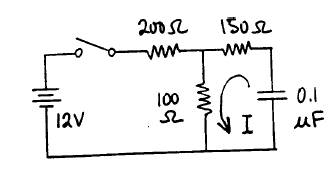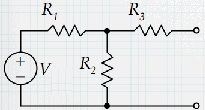Transients, RC circuits
Problem:
In the circuit shown, the switch is opened at t = 0, after
having been closed for a long time. Find
the current I as a function of time for t > 0.

Solution:
- Concepts:
RC circuits
- Reasoning:
While the switch is closed the charge on the capacitor is Q = CV.
When the switch is opened the capacitor discharges through
the resistor.
- Details of the calculation:
While the switch is closed the voltage across the capacitor
is 4 V.
When the switch is opened the capacitor discharges through
a 250 Ω resistor.
V = V0exp(-t/τ),
τ
= RC.
V = (4 V)exp(-t/(2.5*10-5 s)).
I = V/R =
(1.6*10-2 A) exp(-t/(2.5*10-5 s)).
Problem:
Consider the RC circuit below with a switch S that can be opened and closed.

The capacitor is uncharged when, at t = 0, the switch is
closed. Current begins to flow and the capacitor will charge.
(a) Write the equation relating the charge on the
capacitor Q(t) and the current in the circuit I(t) to V0 and time.
(b) Solve for the voltages VC(t) across the
capacitor and VR(t) across the resistor.
(c) Sketch VC(t) and VR(t).
Solution:
- Concepts:
RC circuits
- Reasoning:
We are asked to analyze the transient behavior of an RC circuit.
- Details of the calculation:
(a) V0 - RdQ/dt - Q/C = 0, dQ/dt = I(t)
= V0/R - Q/(RC).
(b) Q(t) = CV0(1 - exp(-t/(RC)), VC(t)
= V0(1 - exp(-t/(RC)),
I(t) = (V0/R)exp(-t/(RC)), VR(t)
= V0exp(-t/(RC).
(c)

Problem:
(a) Suppose a capacitor is charged by a voltage source, and then switched to a
resistor for discharging. Would a larger capacitance value result in a
slower discharge, or a faster discharge? How about a larger resistance value?

(b) Now consider an inductor, "charged" by a current source and then
switched to a resistor for discharging. Would a larger inductance value
result in a slower discharge, or a faster discharge? How about a larger
resistance value?

Solution:
- Concepts:
Transients in circuits
- Reasoning:
The transient behavior of a circuit is characterized by is time constant
τ.
- Details of the calculation:
(a) τ = RC.
Larger capacitance --> slower discharge
Larger resistance --> slower discharge
(a) τ = L/R.
Larger inductance --> slower discharge
Larger resistance --> faster discharge
Problem:
(a) In the RC circuit shown, V abruptly changes value from V1 to
V2 at t = 0 after having been at V1 for a long time. Find the expression for the capacitor voltage as
a function of time.

(b) In the RC circuit shown, V abruptly changes value from V1 = 6 V to
V2 = 15 V at t = 0 after having been at V1 for a long
time. Find the expression for the capacitor voltage as
a function of time.

Solution:
- Concepts:
Transients in circuits
- Reasoning:
We are asked to analyze the transient behavior of an RC circuit.
- Details of the calculation:
(a) For t < 0 we have VC(t) = V1. Q(t) =
CV1.
For t > 0 we have
dQ/dt = I(t)
= V2/R - Q/(RC).
Q(t) = CV2 - C(V2 - V1)exp(-t/RC).
VC(t) = V2 - (V2 - V1)exp(-t/RC).
(b)
There are different approaches to analyzing this circuit.
(i) Using Kirchhoff's rules:
Use SI units, measure resistance in Ω, voltages in V and C in Farad.
Let I be the current flowing clockwise through R1, I1
bet the current flowing through R2, and I3 be the
current flowing through R3.
Let the bottom plate of the capacitor be at VC relative to the
top plate.
For t > 0 we have
15 - 5*103I - 104I1 = 0.
Q/C - (20*103/3)I2
+ 104I1 = 0.
I1 + I2 = I. I2 = -dQ/dt.
Eliminate I = I1 + I2 from the first
equation:
15 - 15*103I1 - 5*103I2 = 0.
I1 = 10-3 + (5/15) I2.
Eliminate I1
from the second equation:
Q/C - (104)I2 + 10 = 0.
I2 = 10-4 Q/C + 10.
dQ/dt = -10-3 - Q/(104C).
Assume Q = A - Bexp(-t/x).
dQ/dt = B/x = -Q/x + A/x
x = 104C = 2.5*10-3s, A =
-10C.
Q(t) = -10C - Bexp(-t/2.5*10-3 s).
VC(t) =
-10 V - (B/C)exp(-t/2.5*10-3 s).
Initial condition: V(0) =
-(2/3)6 V = -4 V.
B/C = -6 V.
VC(t) = -10 V + 6 V exp(-t/2.5*10-3 s).
(ii) Using Thevenin equivalent circuits:

εeff = VR2/(R1 + R2) = 2V/3.
Zeff = R3 + R1R2/(R1
+ R2) = 10 kΩ.
The equivalent circuit looks like this,

VC(t) =
-10 V + 6 V exp(-t/(RC)) = -10 V + 6 V
exp(-t/2.5*10-3 s),
if the bottom plate of the capacitor is at VC relative to the top
plate.









